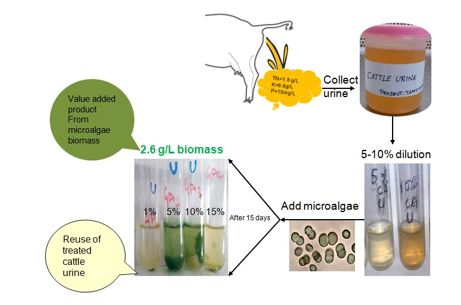Document Type : SHORT COMMUNICATION
Authors
- A. Suresh 1, 2
- S. Tamilvanan 1
- K. Harini 1
- H.V. Seventhi 1
- R. Deepan Guna 1
- R. Mahalakshmi 1
- S. Suriyapriya 1
- D. Sharmila 1
- M. Thenmozhi 1
1 Department of Biotechnology, School of Life Sciences, Vels Institute of Science, Technology and Advanced Studies, Chennai-600117, Tamil Nadu, India
2 Department of Biotechnology, College of Biological and Chemical Engineering, Addis Ababa Science and Technology University, Addis Ababa-16417, Ethiopia
Abstract
Thenutrient medium used for the cultivation of microalgae adds more cost to its value-added product as well as the commercial scale application. Therefore in this study, focused feasibility of cattle urine as a cheap source of nutrients for microalgal growth, because, it contains various minerals and economical which may support the growth of microalgae and reduce the medium cost. To check this, fresh cattle urine was collected, characterized, diluted and inoculated microalgae species Oscillatoria-SRA (Stagnant rainwater algae), Oscillatoria-CWA (Cooum waste algae), Chlorella and Synecocystis separately and incubated under fluorescent light with 8 hours light and 16 hours dark cycle. The biomass was quantified after 15 days and found out variation in biomass quantity in all microalgae isolates. The maximum of 2.6 g/L biomass was produced in Chlorella sp., at 10% urine, followed by Synechocystis sp., (2.25 g/L in 10% urine), Oscillatoria sp.,-SRA (1.3 g/L in 5% urine) and Oscillatoria sp.,-CWA (0.3 g/L in 1% urine). Moreover, lipid quantity was shown at the maximum of 12% dry weight in Oscillatoria sp-SRA., trailed by the 10% in Chlorella sp., 7% in Synecocystis sp., and the least of 5% in Oscillatoria sp-CWA. This study divulged that cattle urine alone is being able to support microalgae growth at a significant amount, thus convalescing industrial production of microalgae ultimately will reduce the cost of microalgal value-added products.
Graphical Abstract
Highlights
- Chemical nutrients used for growing microalgae add more cost to its production, while cheaply available cattle urine contains a rich source of nutrients;
- 10 % of cattle urine produced 2.6 g/L Chlorella sp., and 2.25 g/L Synecocystis sp.;
- Microalgae produced in cattle urine observed 12% lipid in Oscillatoria sp.;
- Cattle urine alone can support microalgae growth, thus convalescing commercial production.
Keywords



Letters to Editor
[1] Letters that include statements of statistics, facts, research, or theories should include appropriate references, although more than three are discouraged.
[2] Letters that are personal attacks on an author rather than thoughtful criticism of the author’s ideas will not be considered for publication.
[3] Letters can be no more than 300 words in length.
[4] Letter writers should include a statement at the beginning of the letter stating that it is being submitted either for publication or not.
[5] Anonymous letters will not be considered.
[6] Letter writers must include their city and state of residence or work.
[7] Letters will be edited for clarity and length.
Send comment about this article